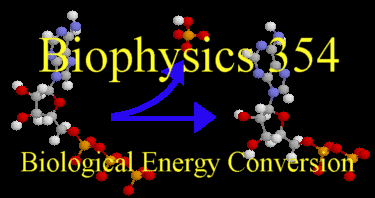Original URL: http://www.life.uiuc.edu/crofts/bioph354/index.html
Introduces and explores the major mechanisms of energy conversion in biology, with particular emphasis on respiratory and
photosynthetic bioenergetics, and the physico-chemical tools required to describe these processes.
Course Outline
Lecture 1. Introduction to biological energy conversion, overview and global perspective
Lecture 2. Review of anaerobic metabolism (glycolysis)
Lecture 3. Elementary chemical thermodynamics; thermodynamic functions; equilibrium constant, pH, pK, enthalpy, entropy and free energy
Lecture 4. Review of aerobic metabolism (citric acid cycle)
Lecture 5. Coupling between reactions; DGo’ for ATP hydrolysis; redox reactions; electrode potential and relation to free energy.
Lecture 6. Electron transport chains; overview and redox components
Lecture 7. Effects of ligands, H+, on redox potential; Quinone redox states; Redox potentiometry
Lecture 8. Electron transport chains as proton pumps.
Lecture 9. Chemical potential; electrochemical potential; membrane potential; coupling between electron and proton transport.
Lecture 10. ATP synthesis and the ATP synthase.
Lecture 11. The proton circuit, the membrane, and the interface (protodes).
Lecture 12. Proton conduction, stoichiometry
Lecture 13. Methodology, a brief review
Lecture 14. Transport across biological membranes: metabolite transport in the mitochondria
Lecture 15. Transport systems in bacteria and eukaryote cells, and the role in homeostasis
Lecture 16. Motility: flagella, muscles, cilia, microtubules.
Lecture 17. Chemical and mechanical work
Lecture 18. Kinetics: simple rate equations
Lecture 19. Kinetics: factors determining the rate of reaction
Lecture 20. Photosynthesis: overview, and light harvesting
Lecture 21. Fluorescence as a probe of photosynthetic function
Lecture 22. Photochemical reaction centers
Lecture 23. Kinetics and thermodynamics of reaction centers
Lecture 24. Photosystem II; Secondary acceptors and donors
Lecture 25. Oxygen evolution: details of mechanism
Lecture 26. Photosynthetic electron transfer; Photosystem I; coupling to metabolism
Lecture 27. Coupling in the steady state; introduction to non-equilibrium thermodynamics
Links
 Crofts Lab Home Page
Crofts Lab Home Page
 Biophysics Home Page
Biophysics Home Page
 Microbiology Home Page
Microbiology Home Page
 The bc1-complex Home Page
The bc1-complex Home Page
 The cytochrome oxidase Home Page
The cytochrome oxidase Home Page
 The Complex I Home Page
The Complex I Home Page
 The Klotho Project - a database of PDB files for some 500 metabolic intermediates.
The Klotho Project - a database of PDB files for some 500 metabolic intermediates.
Chime and Rasmol Links
Rasmol is a program for viewing macromolecular structures coded in the Brookhaven Protein Data Bank (PDB) format. Chime is a plugin for Netscape 3.0 which uses many of the Rasmol commands to allow viewing of PDB files (and many other formats) in the browser.
This course uses Chime-based tutorials extensively, and students are advised to download the requisite software. All PDB files used in Chime tutorials can be downloaded using the File option under the Chime menu. These can then be explored in greater detail using Rasmol.
Download Rasmol from the Rasmol Homepage.
Download Chime
How to use Chime, a brief tutorial.
Draft Chime Manual.
Draft Rasmol Manual (version 2.6).
Molecular Models in Chime, - some examples of biomolecular interest.

 Crofts Lab Home Page
Crofts Lab Home Page The cytochrome oxidase Home Page
The cytochrome oxidase Home Page The Klotho Project - a database of PDB files for some 500 metabolic intermediates.
The Klotho Project - a database of PDB files for some 500 metabolic intermediates.